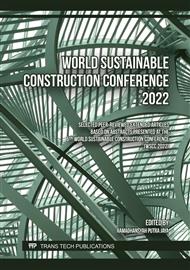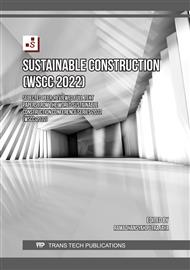[1]
G. Debrunner and T. Hartmann, "Land Use Policy Strategic use of land policy instruments for affordable housing – Coping with social challenges under scarce land conditions in Swiss cities," Land use policy, vol. 99, no. August, p.104993, 2020.
DOI: 10.1016/j.landusepol.2020.104993
Google Scholar
[2]
R. Aziz and U. Muhayani, Seri Buku BRR-Perumahan. 2012.
Google Scholar
[3]
A. Achmad, S. Hasyim, B. Dahlan, and D. N. Aulia, "Modeling of urban growth in tsunami-prone city using logistic regression: Analysis of Banda Aceh, Indonesia," Appl. Geogr., vol. 62, no. 2015, p.237–246, 2015.
DOI: 10.1016/j.apgeog.2015.05.001
Google Scholar
[4]
Syamsidik and A. Suppasri, "Tsunami recovery processes after the 2004 Indian Ocean tsunami and the 2011 Great East Japan Earthquake and Tsunami: Lessons learned and challenges," Int. J. Disaster Risk Reduct., vol. 29, no. xxxx, p.1–2, 2018.
DOI: 10.1016/j.ijdrr.2017.10.019
Google Scholar
[5]
N. Fernando, "Lessons learnt from long term impact of 2004 tsunami relocation: A case study of selected relocation settlements in Akmeemana Divisional Secretary Division in Galle District, Sri Lanka," Procedia Eng., vol. 212, no. 2017, p.47–54, 2018.
DOI: 10.1016/j.proeng.2018.01.007
Google Scholar
[6]
E. Meilianda et al., "Assessment of post-tsunami disaster land use/land cover change and potential impact of future sea-level rise to low-lying coastal areas: A case study of Banda Aceh coast of Indonesia," Int. J. Disaster Risk Reduct., vol. 41, no. August, p.101292, 2019.
DOI: 10.1016/j.ijdrr.2019.101292
Google Scholar
[7]
A.S.J. Foster, T. Rossetto, and W. Allsop, "An experimentally validated approach for evaluating tsunami inundation forces on rectangular buildings," Coast. Eng., vol. 128, no. April, p.44–57, 2017.
DOI: 10.1016/j.coastaleng.2017.07.006
Google Scholar
[8]
Syamsidik, R.S. Oktari, K. Munadi, S. Arief, and I. Z. Fajri, "Changes in coastal land use and the reasons for selecting places to live in Banda Aceh 10 years after the 2004 Indian Ocean tsunami," Nat. Hazards, vol.88, no. 3, p.1503–1521, 2017.
DOI: 10.1007/s11069-017-2930-3
Google Scholar
[9]
W. Soviana, Abdullah, and Syamsidik, "Analisis Kerentanan Bangunan Gedung Dalam Menghadapi Bencana Tsunami Di Kecamatan Kuta Alam Banda Aceh," vol. 6, no. 1, 2015.
Google Scholar
[10]
P. Indonesia, Undang-Undang No 1 Tahun 2011 Tentang Perumahan dan Kawasan Permukiman. 2011.
DOI: 10.31602/al-adl.v13i2.4365
Google Scholar
[11]
K. Pallav, "Housing Model for Urban Area," no. December, 2017.
Google Scholar
[12]
Menteri PUPR, Peraturan Menteri Pekerjaan Umum dan Perumahan Rakyat Republik Indonesia Nomor 14/PRT/M/2017 Tentang Persyaratan Kemudahan Bangunan Gedung. 2017.
DOI: 10.31293/lg.v5i2.5109
Google Scholar
[13]
Menteri Perumahan Rakyat, Peraturan Menteri Negara Perumahan Rakyat Nomor 11/Permen/M/2008 Tentang Pedoman Keserasian Kawasan Perumahan dan Permukiman, no. 42. 2008.
DOI: 10.31293/lg.v5i2.5109
Google Scholar
[14]
BPS Aceh and Bappeda Aceh, Profil Pembangunan Aceh, vol. 53, no. 9. 2019.
Google Scholar
[15]
M. M. Rahmi, N. Najmi, S. Bahri, and M. Suriani, "Analisis Alih Fungsi Lahan Mangrove di Kawasan Pesisir Kota Banda Aceh," J. Aceh Aquat. Sci., vol. 5, no. 2, p.40–51, 2019.
Google Scholar
[16]
W. Soviana and A. Fatimah, "The Analysis of Tsunami Risk Based on the Building Vulnerability and Community Preparedness in Kuta Alam Sub-District Banda Aceh," IOP Conf. Ser. Mater. Sci. Eng., vol. 506, no. 1, 2019.
DOI: 10.1088/1757-899X/506/1/012040
Google Scholar
[17]
F. E. M. A. P.-646 FEMA, "Guidelines for Design of Structures for Vertical Evacuation From Tsunamis 3rd Edition," Jetty.Ecn.Purdue.Edu, no. August, p.176, 2019.
Google Scholar
[18]
F. Damayanti, A. M. Nugroho, and H. Santosa, "Tipologi rumah jawa di kawasan perdesaan sumber polaman lawang," vol. 2, no. 1, p.56–73, 2017.
DOI: 10.29080/emara.2017.3.1.10-22
Google Scholar
[19]
A. S. Cook, "Space and Culture," New Lit. Hist., vol. 29, no. 3, p.551–572, 1998.
DOI: 10.1353/nlh.1998.0027
Google Scholar
[20]
W. Pandelaki, Edward Endrianto; Purwanto, Edi; Olivia, Deasy; Agung, "Faktor-Faktor Pembentuk Kinerja Spasial Rumah Susun Kaitannya Dengan Kepuasan Penghuni," Modul, vol. 15, no. 2, p.85–106, 2015.
Google Scholar
[21]
E. Wulandari and D. Safriana, "Konsep Pengembangan Kota Banda Aceh Sebagai Kota Wisata Tsunami," J. Arsit. ARCADE, vol. 1, no. 1, p.1, 2017.
DOI: 10.31848/arcade.v1i1.8
Google Scholar
[22]
E. N. Bernard et al., "Tsunami: Scientific frontiers, mitigation, forecasting and policy implications," Philos. Trans. R. Soc. A Math. Phys. Eng. Sci., vol. 364, no. 1845, p.1989–2007, 2006.
DOI: 10.1098/rsta.2006.1809
Google Scholar
[23]
F. Ashoka, "Modul Manajemen Bencana Pengenalan Tsunami Untuk Penanggulangan Bencana," 1992.
Google Scholar
[24]
USGS, "Tsunami Hazards — A National Threat," no. December 2004, p.2004–2005, 2006.
Google Scholar
[25]
S. El Moussaoui, R. Omira, M. N. Zaghloul, H. El Talibi, and K. Aboumaria, "Tsunami hazard and buildings vulnerability along the Northern Atlantic coast of Morocco –the 1755-like tsunami in Asilah test-site," Geoenvironmental Disasters, vol. 4, no. 1, 2017.
DOI: 10.1186/s40677-017-0089-6
Google Scholar
[26]
E. Yulianto, F. Kusmayanto, N. Supriyatna, and Dirhamsyah, "Selamat Dari Bencana Tsunami Pembelajaran dari Tsunami Aceh dan Pangandaran Selamat Dari Bencana Tsunami," 2008.
DOI: 10.29103/arj.v1i1.1222
Google Scholar
[27]
F. Dall'Osso, D. Dominey-Howes, C. Tarbotton, S. Summerhayes, and G. Withycombe, "Revision and improvement of the PTVA-3 model for assessing tsunami building vulnerability using 'international expert judgment': introducing the PTVA-4 model," Nat. Hazards, vol. 83, no. 2, p.1229–1256, 2016.
DOI: 10.1007/s11069-016-2387-9
Google Scholar
[28]
M. Saatçioğlu, "Performance of structures during the 2004 Indian Ocean tsunami and tsunami induced forces for structural design," in Earthquakes and tsunamis, Springer, 2009, p.153–178.
DOI: 10.1007/978-90-481-2399-5_10
Google Scholar
[29]
R. K. Eisner, "Planning for tsunami: Reducing future losses through mitigation," Dev. Tsunami-Resilient Communities Natl. Tsunami Hazard Mitig. Progr., p.155–162, 2005.
DOI: 10.1007/1-4020-3607-8_10
Google Scholar
[30]
T. Ito, T. Setoguchi, T. Miyauchi, A. Ishii, and N. Watanabe, "Sustainable downtown development for the tsunami-prepared urban revitalization of regional coastal cities," Sustain., vol. 11, no. 4, 2019.
DOI: 10.3390/su11041020
Google Scholar
[31]
Byrne, Structural Equation Modeling with LISREL, Basic Concepts Applications, and Programming. New Jersey: Lawrence Erlbaum Associates.
Google Scholar
[32]
U. Narimawati, J. Sarwono, A. Affandy, and S. Priadana, Ragam Analisis dalam Metode Penelitian. Bandung: ANDI Yogyakarta, 2020.
Google Scholar
[33]
U. Suharsaputra, Metode Penelitian Kuantitatif, Kualitatif dan Tndakan. Bandung: PT. Refika Aditama, 2012.
Google Scholar
[34]
M. Sarstedt, C. M. Ringle, and J. F. Hair, Partial Least Squares Structural Equation Modeling, no. September. 2017.
DOI: 10.1007/978-3-319-05542-8_15-1
Google Scholar
[35]
N. I. Thusyanthan and S. P. G. Madabhushi, "Tsunami wave loading on coastal houses: A model approach," Proc. Inst. Civ. Eng. Civ. Eng., vol. 161, no. 2, p.77–86, 2008.
DOI: 10.1680/cien.2008.161.2.77
Google Scholar
[36]
P. L. Meyyappan, C. Sivapragasam, T. Sekar, and K. P. Marimuthu, "Suitability of Composite Material in Tsunami Resistant Design," Aquat. Procedia, vol. 4, no. Icwrcoe, p.397–403, 2015.
DOI: 10.1016/j.aqpro.2015.02.053
Google Scholar
[37]
N. Tanaka, Y. Sasaki, M. I. M. Mowjood, K. B. S. N. Jinadasa, and S. Homchuen, "Coastal vegetation structures and their functions in tsunami protection: Experience of the recent Indian Ocean tsunami," Landscape and Ecological Engineering, vol. 3, no. 1. p.33–45, 2007.
DOI: 10.1007/s11355-006-0013-9
Google Scholar
[38]
H. Ismail, A. K. Abd Wahab, and N. E. Alias, "Determination of mangrove forest performance in reducing tsunami run-up using physical models," Nat. Hazards, vol. 63, no. 2, p.939–963, 2012.
DOI: 10.1007/s11069-012-0200-y
Google Scholar
[39]
Tursina, Syamsidik, S. Kato, and M. Afifuddin, "Incorporating dynamics of land use and land cover changes into tsunami numerical modelling for future tsunamis in Banda Aceh," E3S Web Conf., vol. 340, p.01014, 2022.
DOI: 10.1051/e3sconf/202234001014
Google Scholar
[40]
R. Idin, A. Munir, and M. Afifuddin, "Kajian Keandalan Utilitas Bangunan Gedung Rusunawa Di Kota Banda Aceh," J. Arsip Rekayasa Sipil dan Perenc., vol. 1, no. 3, p.131–140, 2018.
DOI: 10.24815/jarsp.v1i3.11778
Google Scholar



